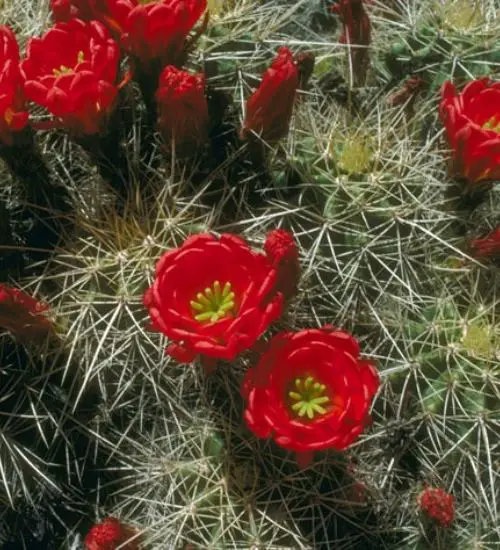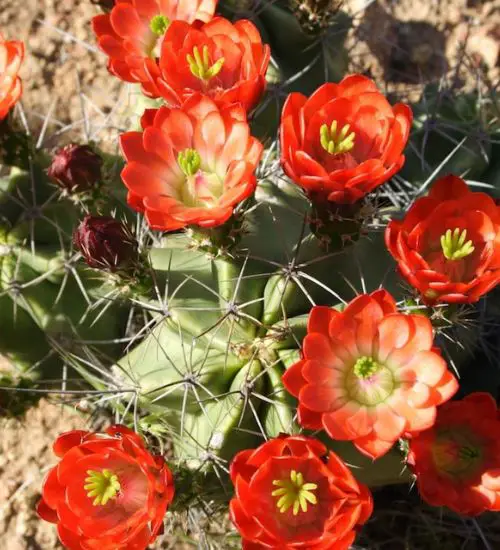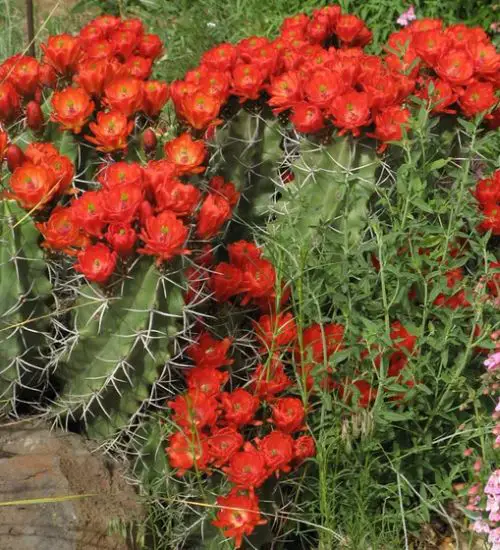Sun: full sun
Water: Typical water needs for a succulent
Temperature: Zone 5a from -20° F to -15° F (-28.9 ° C to -26.1° C) to Zone 9b from 25° F to 30° F (-3.9° C to -1.1° C)
Winter Survival: Cold hardy
Propagation: offsets, seeds
Flower: in the Spring or Summer
Flower Type: Red-Orange
Toxic: Toxic to humans and animals
Dormant: winter
Space Requirement: Indoors & Outdoors
Common Problems: pests
Where to buy Echinocereus Triglochidatus?
Basc Care for Echinocereus Triglochidatus
Watering
You can water your succulent more than often in extreme conditions but make sure that the soil is completely dry before watering your succulent again.
One simple tip for you is that you can use some online apps to check the soil status before you go water your succulents. I would recommend the ThePlantsCheck app, it has some nice features there.
Fertilizing
Only feed this succulent during its active growing seasons which means winter. Use the right fertilizer applied in the right amounts. Applying half-strength balanced fertilizer every month or so is recommended for optimal results.
Do not fertilize during winter as the plant is dormant.
Sun & Location Requirements for "kingcup cactus, claretcup, and Mojave mound cactus."
Echinocereus Triglochidatus requires full sun in order to thrive. When choosing a spot for your succulent, make sure it gets at least 6 hours of direct sunlight per day. If the leaves start to look pale or weak, this could be an indication that the succulent isn't getting enough light.
As per this succulent profile, it is only able to stay healthy when the environment temperature is above the range of zone 5a from -20° F to -15° F (-28.9 ° C to -26.1° C).
Echinocereus Triglochidatus is known for its cold hardiness and ability to survive in frigid winter temperatures. This succulent's thick leaves and stems help it retain moisture, aiding it in surviving freezing temperatures. Additionally, the succulent's attractive foliage offers a festive touch to any garden in cold climates. With its ability to survive down to 0°F, "kingcup cactus, claretcup, and Mojave mound cactus." is an excellent choice for areas with frosty winters.
Any succulents in the group will need a medium space to grow. You can place your pot at your table or window. Since this plant needs more space than mini succulents, you should consider do not plant them together with other succulents/plants.
Propagation
Succulents can be propagated easily by taking offsets from the mother plant and replanting them in fresh soil. The offset will eventually grow into a new succulent that is identical to its parent.
Growing Echinocereus Triglochidatus from seeds is an easy and economical way to produce more plants. Identify a healthy seed by its plumpness, dark color and slightly sticky texture. Once the potting mix has been pre-mixed with well-draining soil, sow the seeds evenly and press lightly into the surface. To ensure germination, keep the container in bright but indirect light and mist the soil gently with a spray bottle.
Toxicity

Echinocereus Triglochidatus is a highly toxic succulent that should be treated with extreme caution to avoid serious health risks. If ingested, it can lead to severe gastrointestinal distress, respiratory problems and even death. It is best to keep this plant away from homes or gardens where humans or animals reside.
Pests and Diseases
Echinocereus Triglochidatus can be affected common pests and diseases like most of the other succulents such as mealybugs and scale insects.
If you do spot any of pest signs, you can treat your succulent using below methods.
- Mealybugs: quarantine, clean infected plants, soapy water.
- Scale insects: quarantine, clean infected plants, soapy water.
Besides that, to prevent serious health issues from happening, keep your succulent in a well-ventilated area and check it regularly for any signs of pests or health problems.


